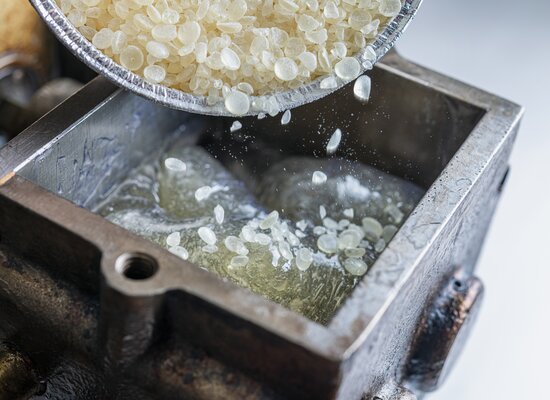We use cookies to provide you with an optimal user experience. Some cookies are necessary for the operation of the site, others are used for statistical purposes, comfort settings, or to display personalized content. You can decide for yourself which cookies you want to allow. Please note that due to your settings, not all functionalities of the site may be available. For more information, please see our Privacy Policy and Cookie Policy.
Details
Classic hot melt Technologies
The Classic Options
At artimelt, we combine decades of experience with the most up-to-date knowledge of the latest developments in hotmelt technology. We make a distinction between pressure-sensitive adhesives (PSA), including UV-curable adhesives that develop their final characteristics only after UVC exposure, and adhesives that are activated by heat, i.e. hot sealers and laminating adhesives (non-PSA).

Typical pressure-sensitive adhesive
The adhesion of PSA adhesives depends on the pressure that is applied. They are normally designed to work perfectly at room temperature. If the temperatures are too low, they lose their adhesion, too high, and they lose their shear resistance. artimelt pressure-sensitive adhesives are based on different polymers, such as synthetic rubber (styrene block polymers), acrylates, polyolefin and new bio-polymers.
Non-PSA adhesives mostly use polyolefin and ethylene vinyl acetate, as well as new bio-polymers.
UV-curable adhesives
artimelt UV hotmelt adhesives based on acrylates are irradiated with UVC light which triggers the crosslinking reaction. The C-range is the shortest wavelength in the ultraviolet spectrum which means the resulting adhesives are resistant to sunlight (UVA and UVB). Commercially available medium-pressure mercury UV lamps, such as those commonly used in the printing industry, are used for crosslinking.
Influencing factors
UV-curable hotmelt adhesives give processors new options. Different adhesion properties can be achieved by varying the degree of crosslinking in the adhesive. This affects the adhesion and shear resistance properties: High internal strength (cohesion) is achieved by strong crosslinking the adhesive, while high adhesion values (adhesion) are achieved by reducing the UV radiation.
Application areas
As a pioneer in this field, artimelt launched the first UV hotmelts for self-adhesive labels in the 1990s. Since then, artimelt has developed hotmelts for a wide range of applications, such as permanent or removable and repositionable labels and adhesive tapes, as well as adhesives for direct contact with skin, such as for wound plasters, adhesive bandages, and dressings.
Advantages
- No drying necessary
- Breathable
- Adhesive is ready to use
- Environmentally friendly – can replace solvent-based systems
- Coating weights up to 125 g/m2
- High transparency
- When fully crosslinked, temperature resistant up to 320°F (160°C) – even up to 392°F (200°C) briefly
- Resistant to plasticizers and chemicals
- UV-resistant – suitable for outdoor applications
- Chemically bonded photoinitiator – no migration
- Components FDA-approved for direct or indirect contact with food
Heat seal adhesives
Heat sealers are usually EVA-based, block-free once opened and can be rolled up without a release aid. They are particularly suitable for producing sterilizable packaging.
Laminating adhesives
Non-PSA hotmelt laminating adhesives are usually polyolefin-based and suitable for bonding multiple layers, for example multilayer membranes, insulation materials or surgical drapes.
Looking for a specific hot melt solution?
artimelt has the answer.
Are you looking for a specific hot melt solution? artimelt has the answer.
We can develop a solution customized to your specific requirements. Send us the key data and most important features of the product you want, and we'll get back to you.
FAQ
Various raw materials are mixed together to create hot melt adhesives. This produces a free-flowing, homogeneous mixture – the hot melt adhesive.
Hot melt adhesives can be used in many different applications, such as:
- Permanent or removable adhesives for labels, adhesive tapes and security applications on many different substrates
- Lamination of decorative materials (textiles, non-wovens) on wood, metal, plastic or composite carriers
- Reclosable packaging
- Highly transparent "clear-on-clear" labels
- Adhesives for direct contact with food
- Textile laminates for construction applications
- Self-adhesive medical products for direct contact with skin
- And many more
We would be happy to develop a customized hot melt solution to meet your specific requirements.
